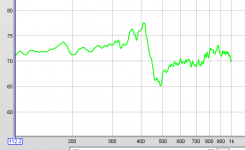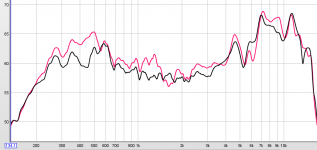Both my drivers do the same thing, so I don't think its defective, but I will check for cracks later.
Just quickly, here is that peak-dip feature I was talking about that also shows up in my martin logan woofer. (green curve) It's just asking to be fixed with a high-q high-shelf filter 🙂 I'm thinking this must be something intrinsic to cone drivers, but I haven't looked into it. Maybe some kind of resonance or mechanical mode.
Red curve is on a 18"x24" open baffle. The dip is not that bad.
I forgot to mention that I can affect this feature by selectively putting blobs of clay on the cone. (black) It can flatten that dip right out.
Do you have a closer than 1m measurement of this driver on an open baffle? I noticed that both the dip and the HF spray are worse when the mic is closer.
Just quickly, here is that peak-dip feature I was talking about that also shows up in my martin logan woofer. (green curve) It's just asking to be fixed with a high-q high-shelf filter 🙂 I'm thinking this must be something intrinsic to cone drivers, but I haven't looked into it. Maybe some kind of resonance or mechanical mode.
Red curve is on a 18"x24" open baffle. The dip is not that bad.
I forgot to mention that I can affect this feature by selectively putting blobs of clay on the cone. (black) It can flatten that dip right out.
Do you have a closer than 1m measurement of this driver on an open baffle? I noticed that both the dip and the HF spray are worse when the mic is closer.
Attachments
Thanks. Try 15cm, 1/48th octave smoothing. Also please try measuring the BACK of the driver, near the vent holes of the spider (if the speaker is mounted on an open baffle, otherwise, never mind).
Both my drivers do the same thing, so I don't think its defective, but I will check for cracks later.
Just quickly, here is that peak-dip feature I was talking about that also shows up in my martin logan woofer. (green curve) It's just asking to be fixed with a high-q high-shelf filter 🙂 I'm thinking this must be something intrinsic to cone drivers, but I haven't looked into it. Maybe some kind of resonance or mechanical mode.
Red curve is on a 18"x24" open baffle. The dip is not that bad.
I forgot to mention that I can affect this feature by selectively putting blobs of clay on the cone. (black) It can flatten that dip right out.
Do you have a closer than 1m measurement of this driver on an open baffle? I noticed that both the dip and the HF spray are worse when the mic is closer.
The green curve looks more like reversed polarity is the problem.
Why would reverse polarity cause a dip in the freq response? I know it can flip the sense of the impulse response.
The green curve looks more like reversed polarity is the problem.
That's a single driver measurement.
I forgot to mention that I can affect this feature by selectively putting blobs of clay on the cone. (black) It can flatten that dip right out.
I use a similar thing on my Eminence 12Lta's - I read BudP's 'EnAble' thread and papers, failed at the tap test.....
He says that the further out the cone diameter you enable the more it affects the 'Highs'.
Now.....
Member Legis also played round with the 12Lta - he put felt spots on the cone, quite a few in fact. I copied this and didnt like the result, so I kept removing and re-arranging them till the sound 'sounded right' 🙂
'Better' might be a better word.
Sorry thought you were referencing the Martin Logans.
At what mic distance is this, baffle size? Can you post the phase, GD and impulse?
At what mic distance is this, baffle size? Can you post the phase, GD and impulse?
Personally, I use 'The Force'.
Legis has all the toys, this link takes you to where he joins thread: Beta12LTa in a 3cf box
http://www.diyaudio.com/forums/full-range/179161-beta-12lta-3cf-box-port-size-32.html
Legis has all the toys, this link takes you to where he joins thread: Beta12LTa in a 3cf box
http://www.diyaudio.com/forums/full-range/179161-beta-12lta-3cf-box-port-size-32.html
In a similar vein but manufactured quite differently and with a very new material, a newly developed 3D printing filament: Spirula Minor – Akemake
In a similar vein but manufactured quite differently and with a very new material, a newly developed 3D printing filament: Spirula Minor – Akemake
Neat. I never knew there was an all wood 3d printing filament material. There must be some plastic in there - how does wood melt and flow with heat like plastic? Why does if have to printed in two halves and glued afterwards? 3d printing should make the whole thing in one pass with appropriate leg supports that can be sanded off later.
Looks cool but foam core is cheaper and faster.
Sorry thought you were referencing the Martin Logans.
At what mic distance is this, baffle size? Can you post the phase, GD and impulse?
Yes, that green curve with the peak-dip at 400Hz IS the martin logan.
As to your questions, are you referring to the martin logan, my speaker in an open baffle, or in the spiral box?
I started another thread in the multi-way forum so as not to clutter up this thread.
Yes, that green curve with the peak-dip at 400Hz IS the martin logan.
As to your questions, are you referring to the martin logan, my speaker in an open baffle, or in the spiral box?
I started another thread in the multi-way forum so as not to clutter up this thread.
I would not have minded if you asked here, but you will get more visibility in the multiway forum and maybe more possible solutions. For those interested the new thread is here:
http://www.diyaudio.com/forums/multi-way/264502-what-causes-peak-dip-frequency-response.html
X,
I saw this and thought of you 🙂
(been looking for tat pic for a while now)
I saw this and thought of you 🙂
An externally hosted image should be here but it was not working when we last tested it.
(been looking for tat pic for a while now)
Thanks, Sippy - I think I have seen it posted before. I feel like it was used as example of sealed spiral TL back somewhere in Cornu thread.
I have a question about the Nautaloss II.. in the beginning of this thread.. its shown with the two Vifa drivers mounted on top of each other.
have you tried placing two Vifa drivers back to back, in push-pull?
and if so, how do they sound different?
I'm wondering how the Vifa would work in that configuration.. and how much the sweet spot would change?
thanks.
have you tried placing two Vifa drivers back to back, in push-pull?
and if so, how do they sound different?
I'm wondering how the Vifa would work in that configuration.. and how much the sweet spot would change?
thanks.
I have a question about the Nautaloss II.. in the beginning of this thread.. its shown with the two Vifa drivers mounted on top of each other.
have you tried placing two Vifa drivers back to back, in push-pull?
and if so, how do they sound different?
I'm wondering how the Vifa would work in that configuration.. and how much the sweet spot would change?
thanks.
I am not sure what you mean back to back on a Nautaloss - one driver facing out and other facing in but mounted in vertical alignment like Nautaloss II - not two drivers face to face with magnet sticking out? The first arrangement with top driver facing out and bottom facing in may reduce 2nd order harmonic distortion a bit for larger excursions. HF will be rolled off on bottom sonit may give natural baffle step correction.
Oh, sorry. I don’t know the correct vocabulary. I'm thinking, like the two drivers facing each other, as in the quad woofer you made.
Is it called Push-Pull?
HF would drop off .. with out any good benefit of other characteristics?
Is it called Push-Pull?
HF would drop off .. with out any good benefit of other characteristics?
Oh, sorry. I don’t know the correct vocabulary. I'm thinking, like the two drivers facing each other, as in the quad woofer you made.
Is it called Push-Pull?
HF would drop off .. with out any good benefit of other characteristics?
That is isobaric push pull. Benefit is less 2nd order harmonic distortion but main reason is it lets you use a chamber volume that is half the volume as single driver. Sensitivity is not increased though. Would only do for woofers as HF really suffers.
- Home
- Loudspeakers
- Full Range
- The Nautaloss Ref Monitor

